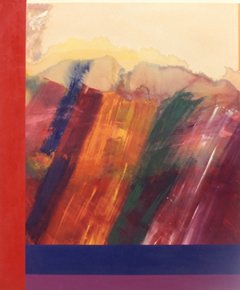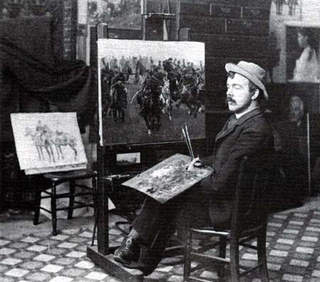Related Research Articles

En plein air, or plein-air painting, is the act of painting outdoors.

Watercolor or watercolour, also aquarelle, is a painting method in which the paints are made of pigments suspended in a water-based solution. Watercolor refers to both the medium and the resulting artwork. Aquarelles painted with water-soluble colored ink instead of modern water colors are called aquarellum atramento by experts. However, this term has now tended to pass out of use.

Thomas Cole was an English-born American artist and the founder of the Hudson River School art movement. Cole is widely regarded as the first significant American landscape painter. He was known for his romantic landscape and history paintings. Influenced by European painters, but with a strong American sensibility, he was prolific throughout his career and worked primarily with oil on canvas. His paintings are typically allegoric and often depict small figures or structures set against moody and evocative natural landscapes. They are usually escapist, framing the New World as a natural eden contrasting with the smog-filled cityscapes of Industrial Revolution-era Britain, in which he grew up. His works, often seen as conservative, criticize the contemporary trends of industrialism, urbanism, and westward expansion.

Albert Pinkham Ryder was an American painter best known for his poetic and moody allegorical works and seascapes, as well as his eccentric personality. While his art shared an emphasis on subtle variations of color with tonalist works of the time, it was unique for accentuating form in a way that some art historians regard as a precursor to modernism.

National Galleries Scotland: Modern is part of National Galleries Scotland, which is based in Edinburgh, Scotland. The Modern houses the collection of modern and contemporary art dating from about 1900 to the present in two buildings, Modern One and Modern Two, that face each other on Belford Road to the west of the city centre.

William Merritt Chase was an American painter, known as an exponent of Impressionism and as a teacher. He is also responsible for establishing the Chase School, which later became the Parsons School of Design.

Charles Warren Eaton (1857–1937) was an American artist best known for his tonalist landscapes. He earned the nickname "the pine tree painter" for his numerous depictions of Eastern White Pine trees.

Robert Seldon Duncanson was a 19th-century American landscapist of European and African ancestry. Inspired by famous American landscape artists like Thomas Cole, Duncanson created renowned landscape paintings and is considered a second generation Hudson River School artist. Duncanson spent the majority of his career in Cincinnati, Ohio and helped develop the Ohio River Valley landscape tradition. As a free black man in antebellum America, Duncanson engaged the abolitionist community in America and England to support and promote his work. Duncanson is considered the first African-American artist to be internationally known. He operated in the cultural circles of Cincinnati, Detroit, Montreal, and London. The primary art historical debate centered on Duncanson concerns the role that contemporary racial issues played in his work. Some art historians, like Joseph D. Ketner, believe that Duncanson used racial metaphors in his artwork, while others, like Margaret Rose Vendryes, discourage viewers from approaching his art with a racialized perspective.

Ronnie Landfield is an American abstract painter. During his early career from the mid-1960s through the 1970s his paintings were associated with Lyrical Abstraction, and he was represented by the David Whitney Gallery and the André Emmerich Gallery.

Soren Emil Carlsen was an American Impressionist painter who emigrated to the United States from Denmark. He became known for his still lifes. Later in his career, Carlsen expanded his range of subjects to include landscapes and seascapes as well.

Joseph Henry Sharp was an American painter and a founding member of the Taos Society of Artists, of which he is considered the "Spiritual Father". Sharp was one of the earliest European-American artists to visit Taos, New Mexico, which he saw in 1893 with artist John Hauser. He painted American Indian portraits and cultural life, as well as Western landscapes. President Theodore Roosevelt commissioned him to paint the portraits of 200 Native American warriors who survived the Battle of the Little Bighorn. While working on this project, Sharp lived on land of the Crow Agency, Montana, where he built Absarokee Hut in 1905. Boosted by his sale of 80 paintings to Phoebe Hearst, Sharp quit teaching and began to paint full-time.
Georg Arnold-Graboné was a painter of German impressionism and an art teacher. Because Grabone is not his real surname, sometimes his name appears as Georg Arnold-Graboné.

William Brooke Thomas Trego was an American painter best known for his historical military subjects, in particular scenes of the American Revolution and Civil War.

William Alexander Sutton was a New Zealand portrait and landscape artist.

John Nelson Shanks was an American artist and painter. His best known works include his portrait of Diana, Princess of Wales, first shown at Hirschl & Adler Gallery in New York City, April 24 to June 28, 1996, and the portrait of president Bill Clinton for the National Portrait Gallery.
California Tonalism was art movement that existed in California from circa 1890 to 1920. Tonalist are usually intimate works, painted with a limited palette. Tonalist paintings are softly expressive, suggestive rather than detailed, often depicting the landscape at twilight or evening, when there is an absence of contrast. Tonalist paintings could also be figurative, but in them, the figure was usually out of doors or in an interior in a low-key setting with little detail.
William Alexander, known as Bill Alexander on his TV show, was a German painter, art instructor, and television host. He was the creator and host of The Magic of Oil Painting (1974–1982) television series that ran on PBS in the United States. He co-wrote The Art of Bill Alexander and … (1987–1995), a series of books on wet-on-wet oil painting, based on different PBS series of the same form. He also taught the television painter Bob Ross his signature "quick" wet-on-wet technique.

Robert Carpenter Spencer was an American painter who received extensive recognition in his day. He was one of the Pennsylvania impressionists, but is better known for his paintings of the mills and working people of the Delaware River region than for landscapes. His work is held in numerous public collections.

Robert Norman Ross was an American painter and art instructor who created and hosted The Joy of Painting, an instructional television program that aired from 1983 to 1994 on PBS in the United States, CBC in Canada, and similar channels in Latin America, Europe and elsewhere.

Robert Bordo is a New York-based, Canadian-American artist known for paintings that blend modernist formal concerns with postmodern approaches to image, subject matter and metaphor. Throughout his career, he has worked in painting series positioned between representation and abstraction that critics characterize as conceptually structured, yet sensual in execution. These series explore recurring, often overlapping themes, such as memory and experience, the passage of time, landscape and weather phenomena, mapping, and mark-making as an indicator of thought. New York Times critic Roberta Smith described Bordo's early map paintings as charting an idiosyncratic "hybrid discipline … a kind of cartographically conscious rerouting of modernism"; in a 2019 New Yorker review of his "crackup" paintings, Andrea Scott wrote, "Bordo's imagery is an apt metaphor for our current, contentious political climate, but his true subject is painting itself: how easily it can tip realism into abstraction or shift figure-ground relations until it's impossible to discern whether you’re on the inside looking out or vice versa."